If you’ve ever noticed black specks in your water after it’s been filtered, you might be wondering what they are – and whether they’re safe to drink. Are black specks in your filtered water a sign of a design flaw of the filter itself? And are these specks safe to consume?
We’ll be answering these questions and more in this guide.
📖 TL; DR
Black specks in your filtered water are most likely carbon dust from the filter media. Consuming activated carbon dust is safe, but there are steps you can take to reduce these particles in your water.
Table of Contents
- 🤔 Why Are there Black Specks in Filtered Water?
- 🔎 Are Black Particles in Filtered Water a Sign of Mold?
- ❔ Which Filters Have Loose Carbon Particles?
- 🩺 Is Carbon Dust from a Water Filter Harmful?
- 🚫 How to Prevent Black Particles in Filtered Water
- ⛔️ How to Stop Black Particles from Coming Out of your Filter
- 💭 Brita Filter Black Specks in Water
- 🧠 Black Particles in Filter FAQs
🤔 Why Are there Black Specks in Filtered Water?
There are two typical causes of black specks in filtered water: loose carbon from the filter media and contaminants in your water.
1) Loose Carbon Dust from the Filter Media
The most likely cause of black specks in filtered water is carbon particles from the filter media.
During the manufacturing and delivery of carbon filters, some of the carbon in the media can become loose. This causes the black particles to escape into your water supply.
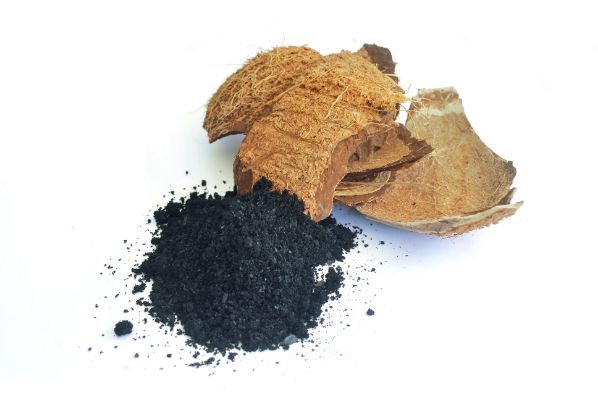
2) Contaminants In your Water
The less likely cause is that the contaminants in your water are causing it to turn black. Perhaps your water filter is only capable of removing certain contaminants, and minerals like manganese and iron aren’t removed. These minerals are known to give water a black tinge if they react with oxygen.
If you notice black particles in your water before it passes through the filter, it probably contains iron or manganese.
🔎 Are Black Particles in Filtered Water a Sign of Mold?
Your first thought after noticing black particles in your water is probably something like, “Oh no, mold.” But can black particles ever be a sign of mold?
They can be – but it’s unlikely. Mold will only grow on your water filter if you don’t change it as frequently as recommended. So, if your filter has a three-month lifespan and you keep using it for 12 months, there’s a good chance that it’ll accumulate mold.
The easiest way to prevent mold growth on your filter is to change it according to the manufacturer’s instructions. Clean the pitcher frequently, too, to prevent mold growth on the inside of the jug.
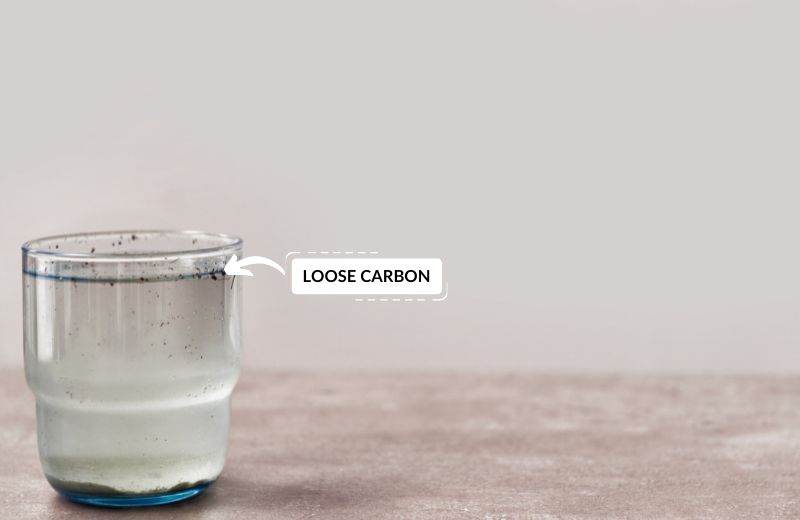
❔ Which Filters Have Loose Carbon Particles?
The most common filters that have loose carbon particles are water pitcher filters. The Brita filter pitcher is especially common for having loose particles of carbon.
If your filter is prone to loose carbon granules, your user manual will likely explain the steps to take to prevent this carbon from getting into your water.
🩺 Is Carbon Dust from a Water Filter Harmful?
The black dust from a water filter might look unappealing, but it’s harmless. Manufacturing activated carbon is safe for human consumption, and it isn’t regulated by the EPA. This means there’s no maximum amount of carbon we can consume that’s deemed “unsafe”.
Luckily, you won’t drink a massive amount of activated carbon from a filter, anyway. There are only a few loose particles in the average granular activated carbon filter, and these should all be removed if you soak and flush filters properly (more on that below).
Activated carbon has adsorptive properties, so there’s a slim chance that this material could adsorb important minerals in your body. But that’s highly unlikely to be an issue unless you consume unusually high amounts of activated carbon.
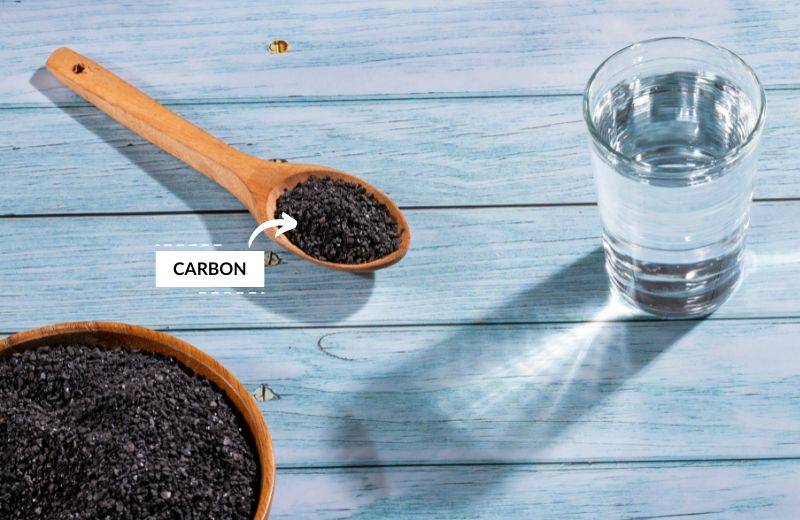
🚫 How to Prevent Black Particles in Filtered Water
The best way to prevent black particles in your filtered water is to follow your manufacturer’s instructions to flush the water filter before use.
Flushing a filter is easy: you just soak it in water or run it under cold water for around 5 to 15 minutes.
This encourages the loose particles of activated carbon to escape from the filter media and get washed away down the drain. When you install the filter, it should be ready to use, with no more loose carbon.
Once you’ve flushed and soaked your filter, you can use the water for non-drinking purposes, like watering your plants.
⛔️ How to Stop Black Particles from Coming Out of your Filter
Perhaps you’ve followed the manufacturer’s instructions to flush your activated charcoal filter, but you’re still noticing black particles in your water. Why is this happening, and what can you do?
While the manufacturing process is most likely to encourage loose carbon particles in your filter, there are several other causes for black particles to be released later down the line:
1. The Filter Contains Trapped Air Bubbles
Sometimes, your filter might contain trapped air bubbles that cause loose particles to remain inside the media.
To resolve this issue, check for trapped air bubbles by placing the filter in a bucket of cold water. A floating filter likely contains bubbles that are trapped.
If your filter floats, repeat the soaking and flushing process again:
- Place the filter upright in cold water for up to 15 minutes.
- Run the filter under cold water for 20 to 30 seconds.
- Still holding the filter in an upright position, gently tap the filter on the side of your sink. This should remove any trapped activated charcoal particles.
- Place the filter back in the bucket of water. If it still floats, repeat the process again until all the trapped air bubbles are removed.
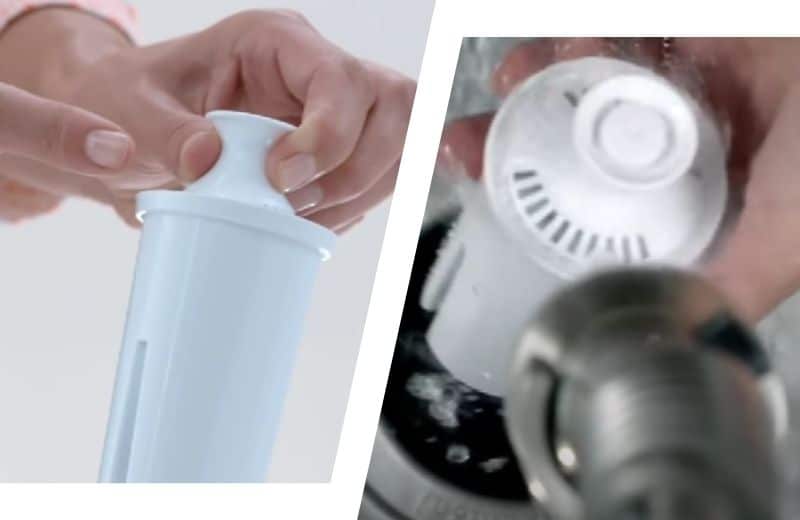
2. You’re Flushing the Filter with Aerated Water
You might actually be causing air to become trapped in the carbon filter if you’re flushing it with aerated water.
Many drinking water faucets have an aerator attachment, which can cause more air bubbles to become trapped in your new filter as you flush it.
To avoid contributing to the air bubbles trapped in the filter, only partially turn on your tap. This will reduce the water pressure and prevent air bubbles from leaving the faucet.
💭 Brita Filter Black Specks in Water
Brita filters are commonly known for releasing black specks into filtered water. But are these specks in Brita filters harmful?
No. A Brita filter has a similar design to all other activated charcoal filters currently on the market. So, they release black particles into your tap water like other tightly-bound carbon block filters do.
It’s safe to drink the water produced from a Brita filter, but if you’d rather your water didn’t contain black spots, the solution is simple: flush your Brita filter before you use it.
Different Brita filters have different instructions for flushing and soaking. The Standard, LongLast, and Stream filters all need to be pre-soaked for 15 minutes, then flushed under running water for 15 seconds.
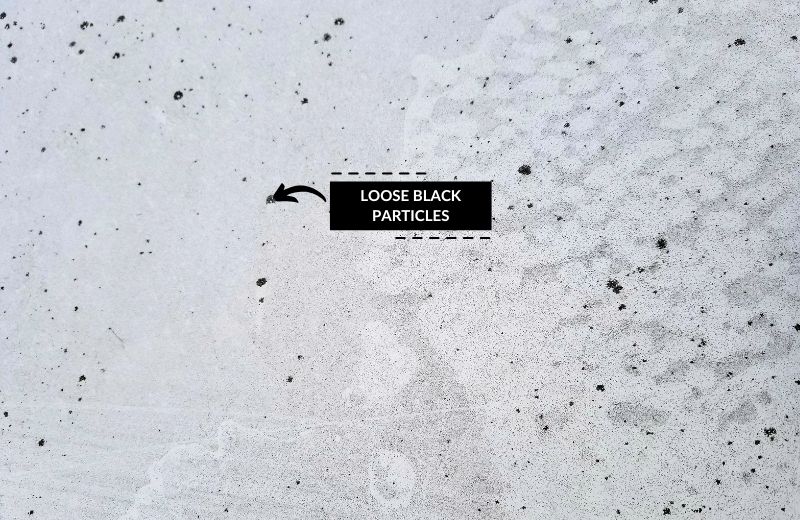
🧠 Black Particles in Filter FAQs
Is the carbon in water filters safe?
Yes, the carbon in filters is safe to drink. The EPA doesn’t regulate carbon, and there’s no official Maximum Contaminant Level (MCL) for this contaminant.
Can a carbon filter make you sick?
No, a filter made from carbon can’t make you sick. In fact, a carbon filter reduces contaminants with health concerns, like chemicals and disinfection byproducts, so it’s good for you.
The only way that you could get sick from carbon filtration is if you didn’t change the filter on time. Old filters are prone to bacteria and mold buildup, which could make you sick.
Are carbon water filters healthy?
Yes, these filters are healthy because they’re made from natural, safe materials, and they remove health-harmful impurities from water.
Can you drink carbon from Brita filter?
Yes, you can drink black particles from a Brita filter. These particles are harmless – but we recommend flushing your Brita filter before you use it for a better filtration experience.
What is the white stuff in a Brita filter?
The white stuff in Brita filters is most likely caused by mineral deposits. If you have hard water – water that contains a large quantity of calcium and magnesium minerals – you’re likely to notice limescale buildup in your filter. Eventually, this scale could break free from the filter and float around in your water. The only way to prevent scale buildup is to soften your water with a whole home water softener.
Is mold in Brita pitcher harmful?
Yes, mold in Brita pitcher – or any water filter pitcher, for that matter – has the potential to be harmful to your health . Soak and scrub the pitcher in hot, soapy water and replace the filters on time to prevent a buildup of mold.


I just cleaned my Life Straw pitcher and changed the carbon filter. When I added tap water to the pitcher I noticed black specks in water in the filter housing, but not in the filtered water. I used a clear glass cup to pour the tap water into the Life Straw. There were no specks in that water. Where did the specks in water to be filtered come from?
Most likely carbon fines washing out from the new filter
VERY DISAPOINTED, BECAUSE I HAD REGULAR FILTER NOT LONG LAST FILTER AND NEVER HAPAPPEN BEFOR, I CHANGE TO LONGLAST FILTER AND IN 2 MONTHS I GOT BLAK PARTICLES
COULD BE A DIFFERENT MANUFACTURE A ONE WHICH DOES NOT DO IT A GOOD JOB, WE HAVE TO KNOW
Are you referring to Brita filters? The Brita Longlast was rebranded as the Brita Elite